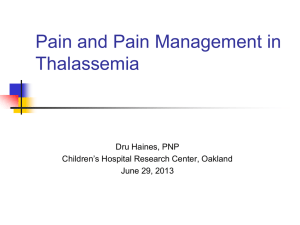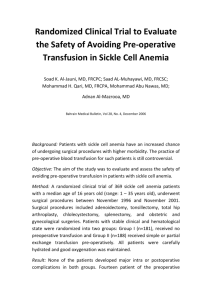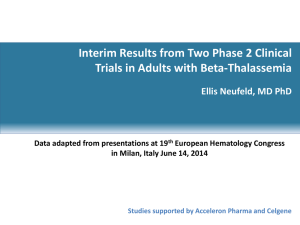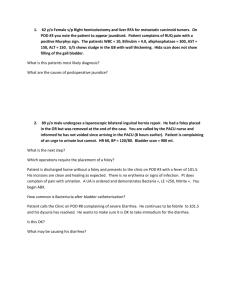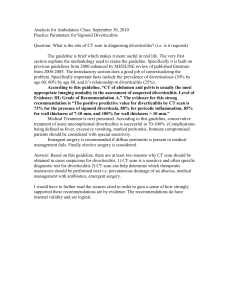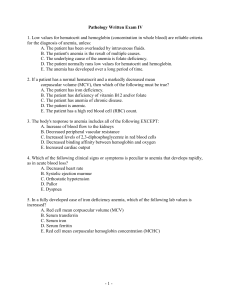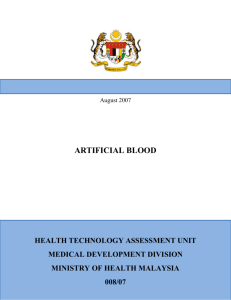Lin cases from 4.5.12
advertisement
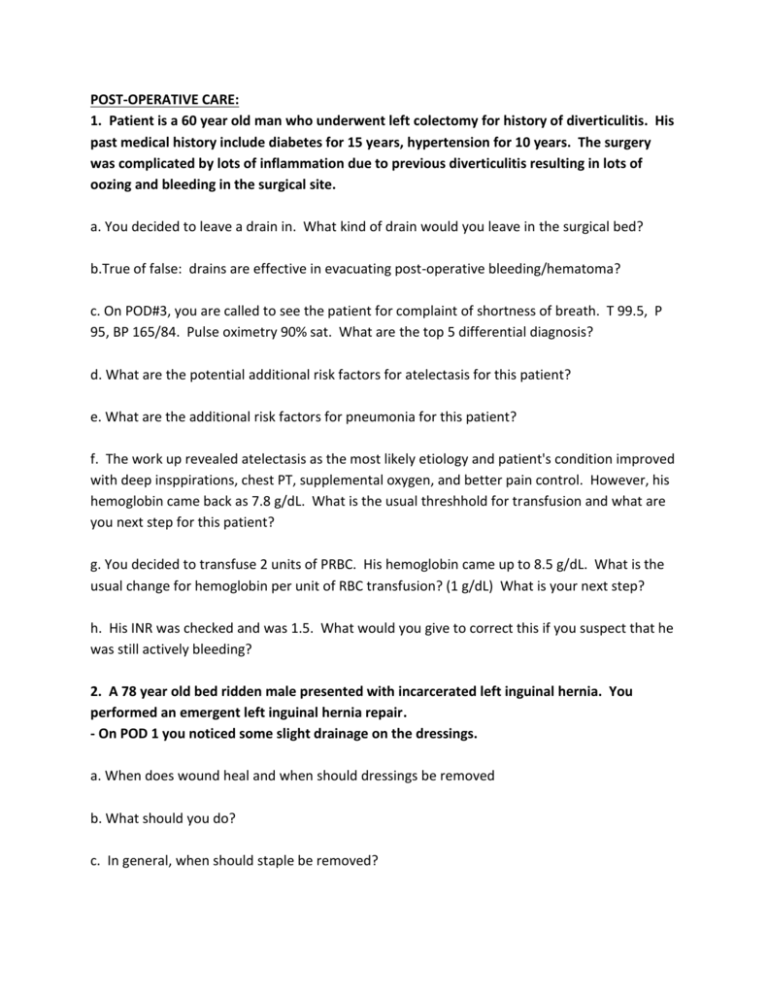
POST-OPERATIVE CARE: 1. Patient is a 60 year old man who underwent left colectomy for history of diverticulitis. His past medical history include diabetes for 15 years, hypertension for 10 years. The surgery was complicated by lots of inflammation due to previous diverticulitis resulting in lots of oozing and bleeding in the surgical site. a. You decided to leave a drain in. What kind of drain would you leave in the surgical bed? b.True of false: drains are effective in evacuating post-operative bleeding/hematoma? c. On POD#3, you are called to see the patient for complaint of shortness of breath. T 99.5, P 95, BP 165/84. Pulse oximetry 90% sat. What are the top 5 differential diagnosis? d. What are the potential additional risk factors for atelectasis for this patient? e. What are the additional risk factors for pneumonia for this patient? f. The work up revealed atelectasis as the most likely etiology and patient's condition improved with deep insppirations, chest PT, supplemental oxygen, and better pain control. However, his hemoglobin came back as 7.8 g/dL. What is the usual threshhold for transfusion and what are you next step for this patient? g. You decided to transfuse 2 units of PRBC. His hemoglobin came up to 8.5 g/dL. What is the usual change for hemoglobin per unit of RBC transfusion? (1 g/dL) What is your next step? h. His INR was checked and was 1.5. What would you give to correct this if you suspect that he was still actively bleeding? 2. A 78 year old bed ridden male presented with incarcerated left inguinal hernia. You performed an emergent left inguinal hernia repair. - On POD 1 you noticed some slight drainage on the dressings. a. When does wound heal and when should dressings be removed b. What should you do? c. In general, when should staple be removed? d. You decided that his staples should stay in longer since he is a debilitated patient. What are some of the other conditions that would require the sutures to stay in longer? 3. A 65 year old man with COPD due to history of smoking underwent a Billroth I for nonhealing PUD and failed medical therapy. He had an NG tube placed intra-operatively. On evening of POD#2, he started complaining of worsening SOB. T 98.0, P 90, BP 150/82, O2 Sat 92%, RR 30. Lung sounds show diffuse crackles bilaterally. Work up showed no acute EKG changes, minimal infiltrate with COPD changes on CXR. ABG on 6L nasal canula O2 showed : PH 7.49, PO2 60, PCO2 25. a. What is your diagnosis? b. What is your next step? c. What are the criteria for respiratory failure? d. True or false: Since NG tube potentially can increase the risk of wound infection and pneumonia, we should not have placed a NG in this patient. e. When would you expect his GI function to return? 4. Transfusion knowledge base: Please pick the most correct answer to the condition described for the patient. a. Washed Red Blood Cells b. Leukocyte-reduced Red Blood Cells c. Irradiated Red Blood Cells d. P Red Blood Cells 1. Patients at risk for transfusion-associated graft versus host disease (TA-GVHD) 2. This decreases the risk of transmission of cytomegalovirus (CMV) infection in immunosuppressed CMV-seronegative patients 3. Patients with severe IgA deficiency 4. Patients experiencing recurrent febrile nonhemolytic transfusion reactions (FNHTRs) to RBCs or platelets 5. Patients with hemoglobin of 7 g/dL From Score Question 1 A 79-year-old female patient has undergone a colonic resection for perforated diverticulitis with significant fecal contamination. She is intubated in the ICU after the surgery and remains critically ill. Describe your approach to this patient. Key Discussion Points a. Discuss resuscitation in the immediate postoperative period. b. Understand the likelihood of prolonged ileus in select patients. c. Discuss assessment for nutritional status and appropriate measures to ensure adequacy. Question 2 A 64-year-old man has undergone a Whipple procedure for pancreatic carcinoma. On postoperative day 3 he becomes short of breath. What is your plan of action? Key Discussion Points a. Discuss the potential for cardiac events in the context of potential risk factors. b. Discuss the potential for venous thromboembolic event in relation to preoperative prophylaxis. c. Discuss potential pulmonary complications. Question 3 A 52-year-old diabetic patient has undergone repair of multiple enterotomies after a penetrating trauma. There has been a lengthy hospitalization due to inability to tolerate feeding. The patient has now developed a fever. Describe your approach. Key Discussion Points a. Demonstrate understanding of the broad differential diagnosis in this patient. b. Systematically work through the differential diagnosis to arrive at the correct etiology. c. Describe the parameters for glycemic control. Question 4 A 45-year-old patient has undergone bilateral mastectomy with muscle flap reconstruction and is now postoperative day 1. Upon evaluation, she is tachycardic, tachypneic, and appears uncomfortable. How would you evaluate and treat this patient? Key Discussion Points a. Perform a thorough history and physical examination. b. Recognize and assess for pain as a potential cause of this symptom complex. c. Describe therapeutic options for pain control after ruling out other causes of symptoms. Question 5 A patient has just exited the OR after a “damage control” laparotomy for trauma in which he was “found down.” The patient has an open abdomen with a dressing in place. He remains hypothermic, hypotensive, and has increasing amounts of blood in the abdominal suction apparatus. Describe your approach to and treatment of this patient. Key Discussion Points a. Recognize potential reasons for ongoing blood loss. b. Obtain appropriate laboratory studies to assess for various etiologies of coagulopathy. c. Expeditiously treat all possible causes effectively.



